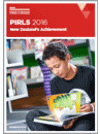The Progress in International Reading Literacy Study (PIRLS) is a research study that provides both trend and snapshot information on the reading literacy of New Zealand's Year 5 students in both the International and national contexts. PIRLS 2015/2016 was the fourth cycle of the study to be administered.
Key Results
|
New Zealand’s mean reading score (523) remained statistically significantly higher than the PIRLS Scale Centrepoint (500) |
|
There was a small, but statistically significant, 8-point decrease in the mean score from PIRLS 2011 to 2016. Results from different groups of children indicate that this change is across the board as it is visible in both genders, across ethnic groups, and in children from well-resourced homes as well as less resourced homes. |
|
A reasonable number of New Zealand children reached the High Benchmark (41%), meaning they demonstrated an ability to engage with increasingly complex texts and questions. |
|
However, slightly fewer children overall reached three of the benchmarks (low, high and advanced) in PIRLS 2016 than in PIRLS 2011. |
|
New Zealand children’s performance was, in general, relatively stronger when reading literary texts than informational texts. |
|
Reading comprehension was relatively stronger when using reasoning strategies (interpreting, integrating and evaluating) than using text-based skills (retrieving and straightforward inferencing). |
|
Girls and boys both generally achieved above the international means. Internationally and in New Zealand, girls tended to have higher reading achievement than boys. The difference between boys and girls is larger in New Zealand than many other countries. |
|
While, as groups, Māori and Pākehā/European children’s mean scores have decreased since PIRLS 2011, there was a moderate increase in the mean for Pasifika children. This was largely due to stronger performance among Pasifika girls. There is more variability in Asian childrens’ reading scores in PIRLS 2016 than in previous cycles, but no change in their mean score. |
|
Children who always or almost always spoke the same language at home as they used in the test (English or te reo Māori), generally had higher reading achievement than those who generally spoke a different language at home from that used in the test. Since PIRLS 2011, the size of this difference has decreased. |
|
New Zealand children were moderately positive about reading, but much less confident about it than their international peers. This is important because children who lacked confidence scored about 120 score points lower, on average, than those who were very confident. |

